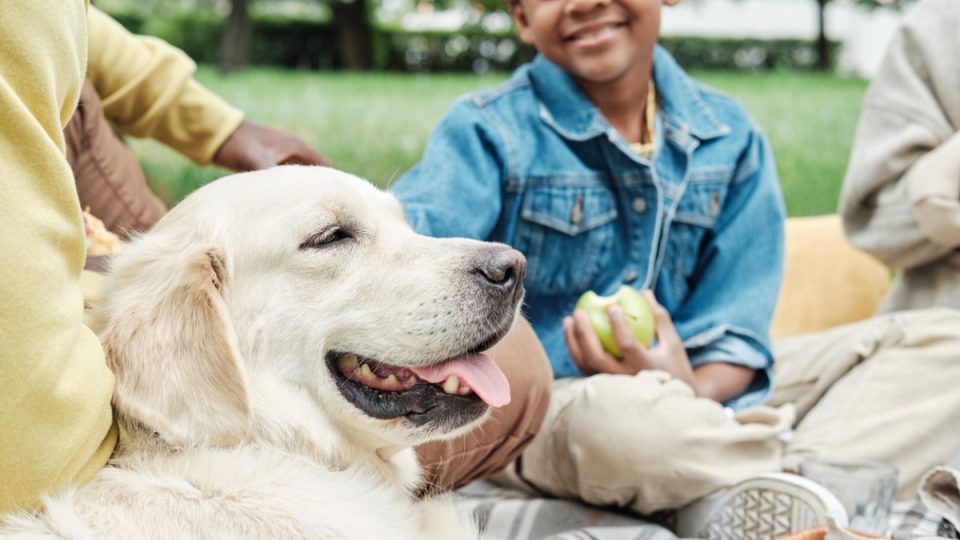- Not a substitute for professional veterinary help.
Mo Vashel has seen the many ways children benefit from having a pet, both with her own children, and in her work as a certified service dog coach and senior dog trainer with Wag It Better Dog Training in Murfreesboro, Tennessee.
“A recent client asked me to train a service dog for her son who has autism and was non-verbal,” Vashel says. “After working with the dog and his speech pathologist, the boy has had a breakthrough and is now very verbal.”
Vashel is far from the only one who understands the many positive impacts a pet can have in a child’s mental development. Countless studies have shown that children who grow up with pets reap significant social, mental, and physical benefits.
For example, autism service dogs have been shown to help children who are on the spectrum gain confidence and independence, decrease social isolation, and increase social interaction. Exposure to dogs in childhood has also been linked to a reduced risk of developing psychiatric disorders, such as schizophrenia, later in life. Having a pet has even been proven to help kids master their reading skills—two studies from the University of California, Davis, found that kids who read with a therapy dog improved their reading skills by 12% in the first study, and 30% in the second.
These are just a few examples from a fast-growing body of research that shows how meaningful a child’s bond with a pet can be. As a staggering number of young people struggle with their mental health, we consider more of the ways kids can benefit from a relationship with cats and dogs.
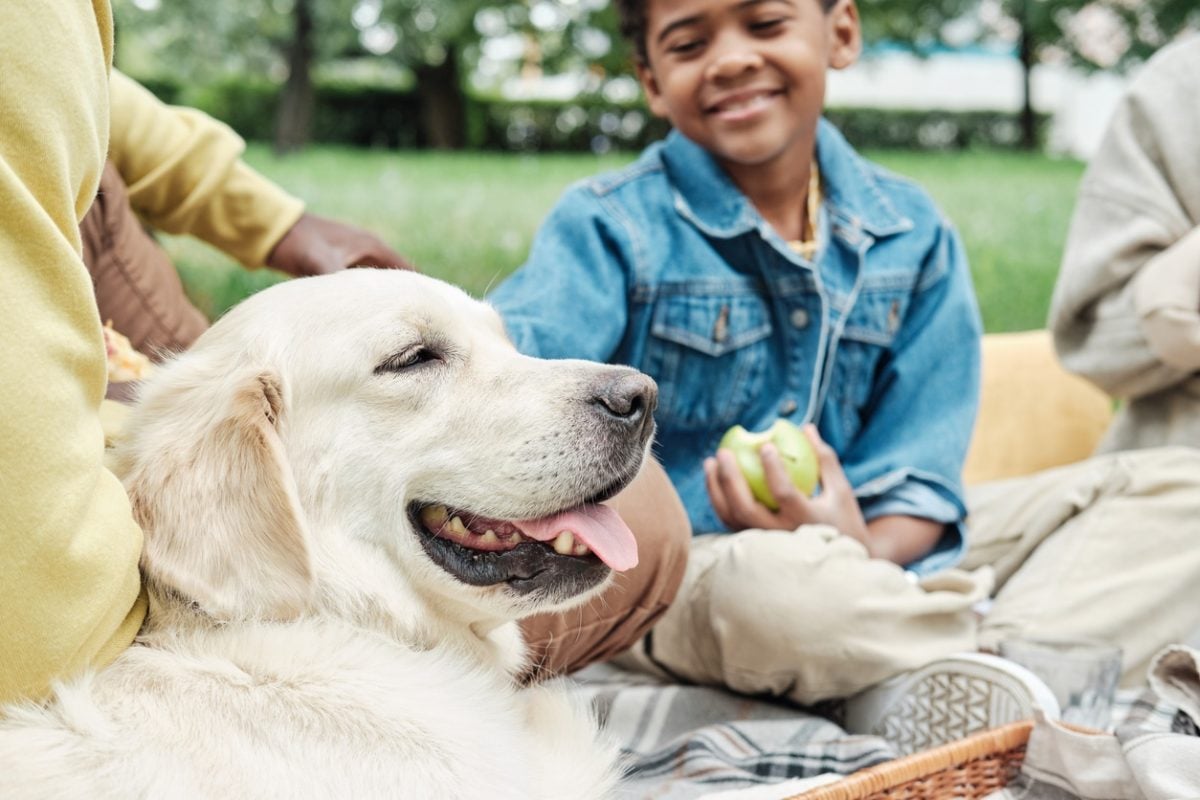
iStock/AnnaStills
Pets Keep Kids Active, Social, and Healthy
Playing and Making Friends
“Dogs need exercise and having your child play with them outdoors or take them on walks offers them both physical benefits,” says Emily Haley, a behavior modification specialist and consultant with The Dog Listener in Dana Point, California.
In fact, some research has shown that walking and playing with a dog can also benefit a child’s social and emotional development. The study, conducted by the University of Western Australia and known as the PLAYCE Observational Study, concluded that children raised in homes with dogs had “better prosocial behaviors,” “lower peer problems and conduct problems,” and overall “positive social–emotional development,” compared to children who didn’t have a dog.
It’s easy to see how having a pet can facilitate social interaction. When Vashel and her family moved from California to Tennessee, she found that being a dog lover provided opportunities to make new friends who were also dog lovers.
Another study out of Australia suggested that “companion animals can be a catalyst for several dimensions of human social relationships in neighborhood settings,” meaning that pets help facilitate social interactions, and sometimes making new friends. And it’s not just dogs that provide these benefits: cats, rabbits, and even snakes have also been shown to provide social support and lead to meeting new people.
Combatting Screen Time
Research from the University of Georgia and San Diego State University found that too much time spent on smartphones and other electronic devices has been shown to have a negative impact on children, leading to anxiety and depression and lower overall well-being.
Dogs and other pets can provide children with friendship and another way to engage their curiosity. The PLAYCE study observed that children who have a dog are more active and spend less time on electronic devices.
Even just reading to a dog has been shown to benefit a child’s well-being, while also reducing anxiety.
Having a pet provides a mental health break and combats screen time overload.
Improving Quality of Life
Vashel has also seen how having a pet can help children with various health conditions, such as diabetes. As the former Director of Behavior and Training at Early Alert Canines, Vashel trained medical alert service dogs to alert their owners with diabetes to when their blood sugar spiked too high or dropped too low. These wonderful working dogs help kids live just like other kids, which improves confidence and encourages a brighter outlook on life.
Some studies have even shown that young children who live with pets have reduced rates of allergic diseases such as asthma and eczema. New evidence shows that infants who are exposed to pets can lower the risk of the child later developing food allergies. Naturally, kids who don’t struggle with frustrating allergies are happier kids.
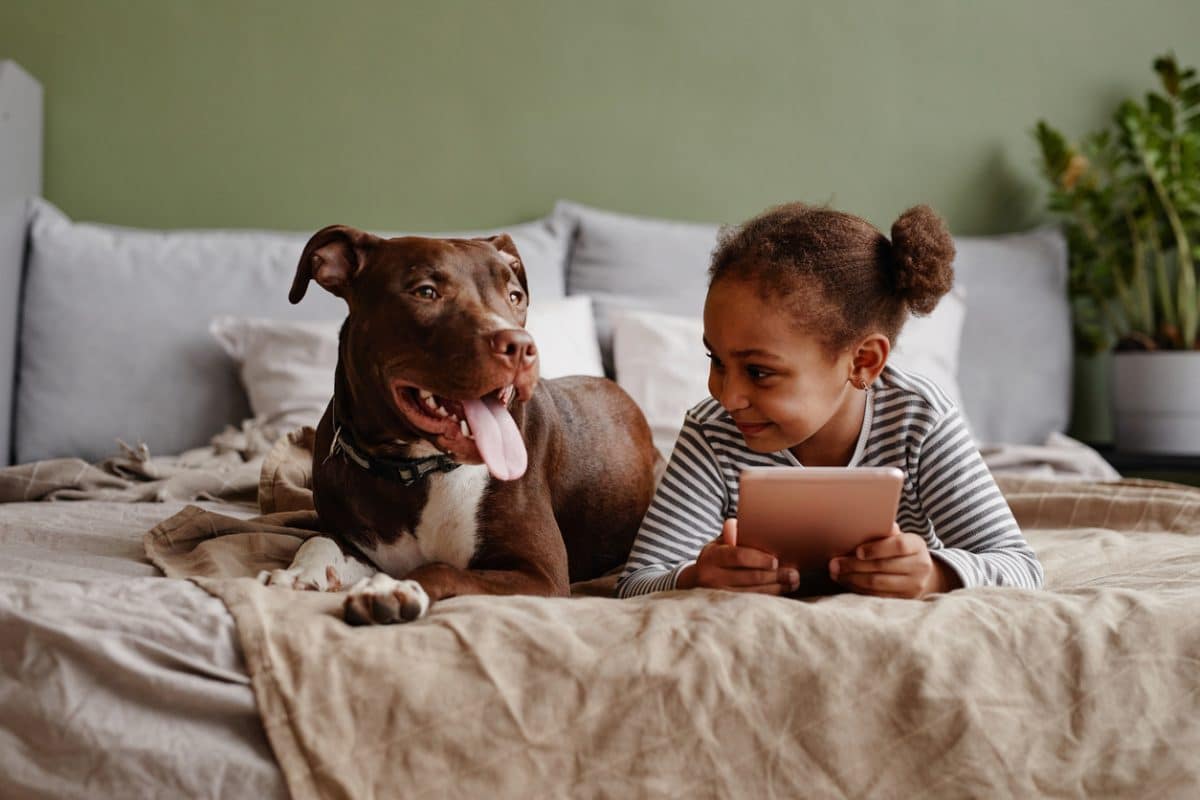
iStock/SeventyFour
Pets Teach Kids Compassion, Empathy, and Acceptance
Perhaps one of the greatest gifts pets give children is unconditional love, says Beverly J. Ulbrich, a canine behaviorist and owner of The Pooch Coach in San Francisco.
“Dogs don’t hold grudges, and will always love you no matter what,” Ulbrich says. “Pets teach children empathy, unconditional love, and compassion, that results in social and emotional benefits.”
And it’s not just dogs who are master teachers.
“Children can confide in their cats in ways they might not do with people especially since cats aren’t judgmental like people can be,” says Stephen Quandt, a feline training and behavior specialist, with Cat Behavior Help in New York City. “Studies have found that children who have pets have a greater ability to express emotion and have better control over their feelings.”
While dogs are good at offering unconditional love, Quandt says cats operate a little differently. They often need to have that love earned, and he notes that accomplishing this can teach children patience and empathy.
“Some people viscerally love the feeling they get when they earn another creature’s love,” Quandt says, and that feeling can boost a child’s desire to feel wanted, needed, and accepted.
Yet even more science confirms just how much a pet can teach a child.
In an online article, the American Academy of Child and Adolescent Psychiatry notes that pets offer kids a triple whammy of benefits that show: “developing positive feelings about pets can contribute to a child’s self-esteem and self-confidence,” “positive relationships with pets can aid in the development of trusting relationships with others,” and that “a good relationship with a pet can also help in developing non-verbal communication, compassion, and empathy.”
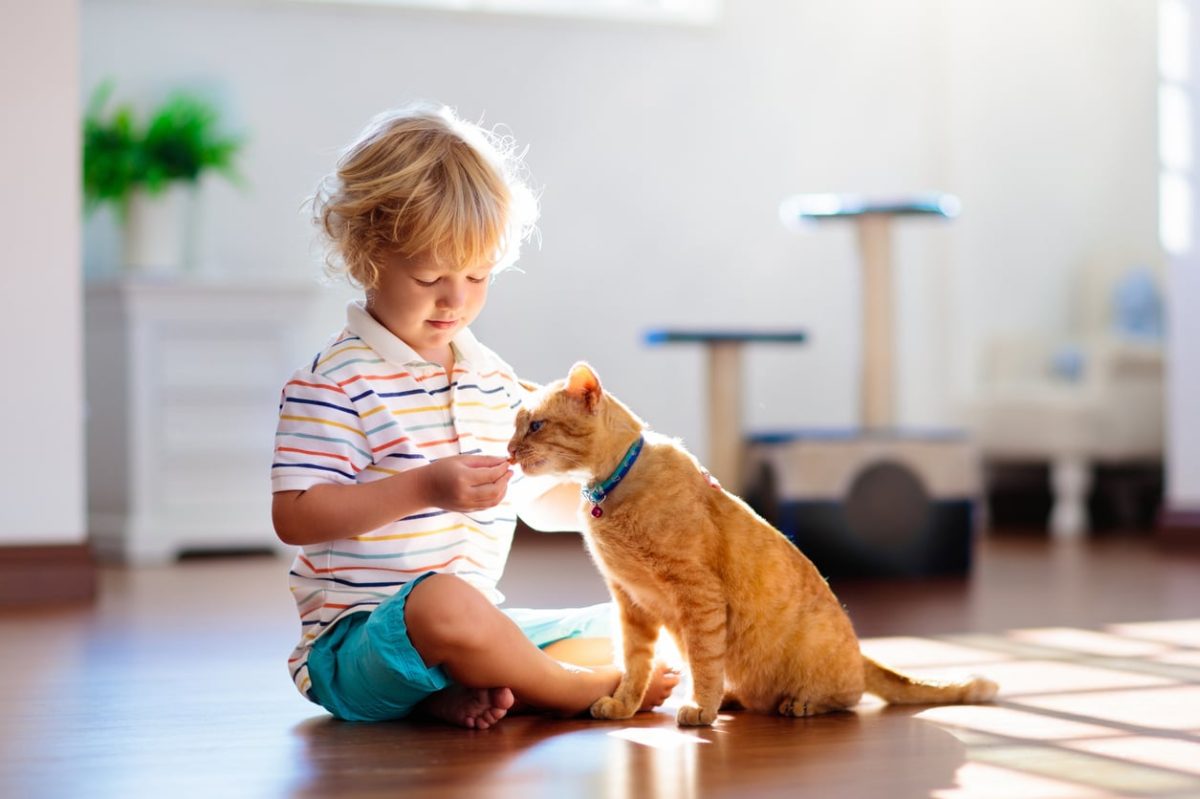
iStock/FamVeld
Pets Teach Kids About Responsibility and Boundaries
Learning to care for a pet also teaches children important life skills including responsibility, trust, respect, and patience.
In her practice, Ulbrich says that since dogs have the reasoning and mental capacity of a four-to-five-year-old child, they need to be raised with the same kindness, compassion, and rules. Having your child assist with teaching your dog boundaries, manners, and discipline, also reinforces these valuable life lessons with your child.
“If you have a young child, you teach them safety lessons, like not running into the street, and boundaries, such as not taking food from another person’s plate,” Ulbrich says. “Dogs need to learn these same behavior skills.”
Quandt encourages parents to have their children help with training the family pet in age-appropriate ways.
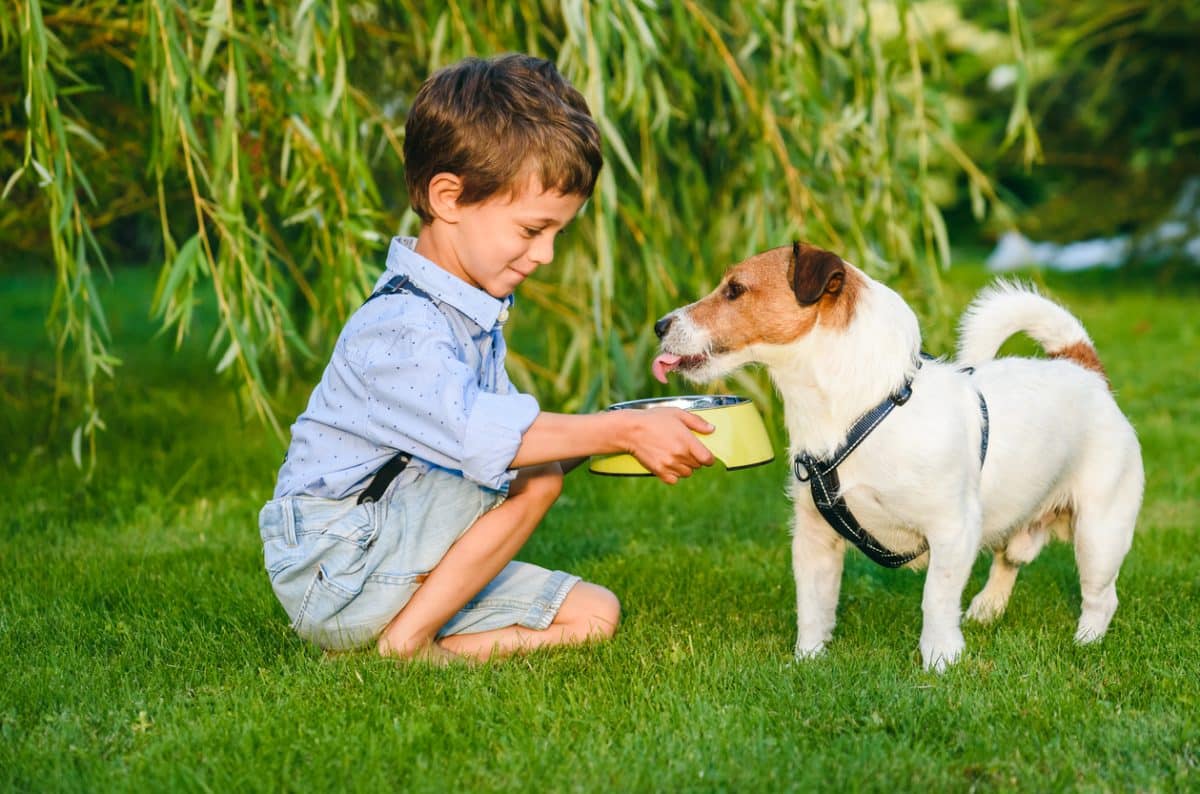
iStock/alexei_tm
“Kids can help with tasks such as feeding, playing, and litter box cleaning,” Quandt says. “Cats often enter into what I call the kitten-mother relationship between themselves and their humans. Kittens want food, comfort, attention, and play, and humans who provide these things can become ‘the mother’ in a cat’s eyes, and that can be deeply satisfying for children to feel wanted.”
Basing the child’s responsibility on their age also ensures they don’t get frustrated. While a five-year-old can’t walk a large dog on their own, they can assist a parent with brushing the dog or refilling their water bowl.
Haley, who specializes in child/dog interactions, works with families on training their dog through positive reinforcement, teaching them basic commands, and demonstrating how kids can safely interact with their new pets.
Not only does training a dog offer children a sense of accomplishment, the interactions have also been shown to significantly lower cortisol (stress hormone) levels in children.
Living with pets also help children learn about boundaries. “It’s important to teach young children that having a dog isn’t all about touch,” Haley says. “You don’t have to be constantly petting your dog, sometimes they might just want to sit right next to you.”
Quandt says this also works with cats. “Teaching your child how to read cat body language will help them communicate with the cat, while also teaching them how to ‘read’ the cat,” he says. “Learning this will help create appropriate and meaningful interactions between your child and cat.”
(For more information about how to safely encourage positive encounters between pets and kids, see our article, “Kids and Pets: What You Need to Know for Safe Interactions.”)

iStock/Wavebreakmedia
Final Thoughts
While pet loving moms and dads have long understood the positive impacts a family dog or cat can have on the kids, the science now overwhelmingly confirms it—having a pet as a child teaches important life skills and boundaries, offers significant benefits to a child’s social and emotional well-being, and helps set kids up for better mental and physical health in the future.
And who knows? The positive effects of having a pet during childhood are just now starting to be widely and seriously studied. Our beloved pets have a way of surprising us, so perhaps there’s much more to come.
